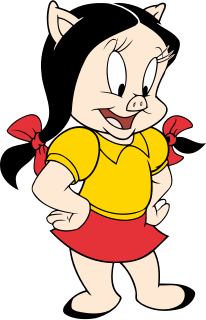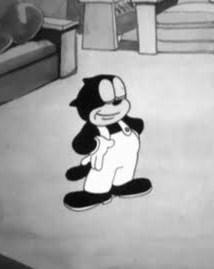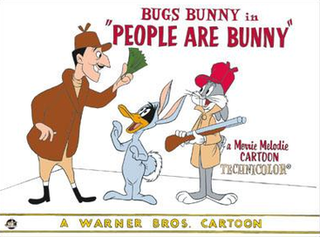
Looney Tunes is an American animated comedy short film series produced by Warner Bros. from 1930 to 1969, along with an accompanying series, Merrie Melodies, during the golden age of American animation. The two series introduced Bugs Bunny, Daffy Duck, Porky Pig, Elmer Fudd, Wile E. Coyote, the Road Runner, Tweety, Sylvester, Granny, Yosemite Sam, the Tasmanian Devil, Foghorn Leghorn, Marvin the Martian, Pepé Le Pew, Speedy Gonzales and many other cartoon characters. The characters themselves are commonly referred to as the "Looney Tunes", as well as the "Tune Squad" since their appearances in the 1996 feature film Space Jam.
Charlie Dog is an animated cartoon character in the Warner Brothers Looney Tunes series of cartoons. The character was featured in eight cartoons between 1947 and 1958.

Merrie Melodies is an American animated series of comedy short films produced by Warner Bros. starting in 1931, during the golden age of American animation, and ending in 1969. As with its partner series, Looney Tunes, it featured cartoon characters such as Bugs Bunny, Daffy Duck, Porky Pig, and Elmer Fudd. Between 1934 and 1943, the Merrie Melodies series were distinguished from the black-and-white, Buddy or Porky Pig–starring Looney Tunes shorts by an emphasis on one-shot stories in color featuring Warner Bros.–owned musical selections. After Bugs Bunny became the breakout recurring star of Merrie Melodies, and Looney Tunes went to color in the early 1940s, the two series gradually lost their distinctions and shorts were assigned to each series more randomly.

Petunia Pig is an animated cartoon character in the Looney Tunes and Merrie Melodies series of cartoons from Warner Bros. She looks much like her significant other, Porky Pig, except that she wears a dress and has pigtailed black hair.

Emma Webster, better known as Granny, is a Warner Bros. Cartoons character created by Friz Freleng, best known from Looney Tunes and Merrie Melodies animated shorts of the 1950s and 1960s. She is the owner of Tweety. Her voice was first provided by Bea Benaderet from 1950 through 1955, then by June Foray for almost 60 years then Candi Milo took over in 2017 following Foray’s death.

The CooCoo Nut Grove is a 1936 Warner Bros. Merrie Melodies short animated film, set in the famed Cocoanut Grove of the Ambassador Hotel in Los Angeles. The cartoon was directed by Friz Freleng, with animation by Robert McKimson and Sandy Walker, caricature design by T. Hee, and musical score by Carl Stalling. The short was released on November 28, 1936.

Beans the Cat is an animated cartoon character in the Warner Bros. Cartoons series of cartoons from 1935–1936. Beans was the third Warner Bros cartoon character star after Bosko and Buddy. He is voiced by Billy Bletcher and occasionally by Tommy Bond. He was created by director Friz Freleng. The character was featured in nine cartoons made in 1935 and 1936.

Life with Feathers is a 1945 Warner Bros. Merrie Melodies animated short film directed by Friz Freleng. The short was released on March 24, 1945, and was the first cartoon to feature Sylvester the Cat.

I Love to Singa is a 1936 Warner Bros. Merrie Melodies animated cartoon directed by Tex Avery. The short was released on July 18, 1936.
Babbit and Catstello are fictional characters, based on the comedic duo Abbott and Costello, that appeared in Warner Bros. animated cartoons. The characters appeared in three cartoons between 1942 and 1946.
"The Merry-Go-Round Broke Down" is a song written in 1937 by Cliff Friend and Dave Franklin and published by Harms Inc., New York. It is best known as the theme tune for the Looney Tunes cartoon series and Merrie Melodies reissued cartoon series produced by Warner Bros. Cartoons, used from 1937 to 1969.

Little Red Walking Hood is a 1937 Merrie Melodies cartoon supervised by Fred Avery. The short was released on November 6, 1937, and features the first appearance of an early character who later became Elmer Fudd.

People Are Bunny is a 1959 Warner Bros. Merrie Melodies cartoon, directed by Robert McKimson The short was released on December 19, 1959, and stars Bugs Bunny and Daffy Duck.
Let It Be Me is a 1936 Warner Bros. Merrie Melodies cartoon directed by Friz Freleng. The short was released on May 2, 1936.
The Fella with the Fiddle is a 1937 Warner Bros. Merrie Melodies cartoon directed by Friz Freleng. The short was released on March 27, 1937.

Ding Dog Daddy is a 1942 Warner Bros. Merrie Melodies cartoon, directed by Friz Freleng and written by Tedd Pierce. The short was released on December 5, 1942, and features Willoughby the Dog.
Hawaiian Aye Aye is a 1964 Warner Bros. Merrie Melodies animated short, directed by Gerry Chiniquy and written by Tedd Pierce and Bill Danch. The short was released on June 27, 1964, and stars Tweety and Sylvester.
A Feud There Was is a 1938 Warner Bros. Merrie Melodies cartoon directed by Tex Avery. The short was released on September 24, 1938 and features the fourth appearance of an early version of Elmer Fudd.

Crosby, Columbo, and Vallee is a 1932 Warner Bros. Merrie Melodies cartoon short directed by Rudolf Ising. The short was released on March 19, 1932. It lampoons the popularity of crooners among young women, with popular crooners Bing Crosby, Russ Columbo, and Rudy Vallée being the namesake of the film.












